Analysis of the Effect of Bivariate Fertilizer Discharger Control Sequence on Fertilizer Discharge Performance
Abstract
1. Introduction
2. Materials and Methods
2.1. Bivariate Fertilizer Discharger
2.1.1. Working Principle of Bivariate Fertilizer Discharge Device
2.1.2. Advantages of the Bivariate Fertilizer Discharge Device
2.2. Fertilizer Discharge Prediction Model Construction
2.2.1. Fertilizer Discharge Calibration Test
2.2.2. Fertilizer Discharge Prediction Model Construction
2.2.3. Prediction Model Accuracy Analysis
2.3. Discrete Element Simulation Test
2.3.1. Simulation Model Establishment and Parameters Setting
2.3.2. Simulation Test Design
2.3.3. Fertilizer Discharge Performance Evaluation Index
3. Results
3.1. Analysis of Simulation Results
3.2. Control Sequence Optimization
3.3. Bench Test Verification
4. Conclusions
- (1)
- A fertilizer discharge calibration test with different fertilizer wheel speeds and openings was conducted on a bivariate outer groove wheel fertilizer discharge device. An RBFNN-based fertilizer discharge prediction model was constructed, and 14 samples that did not participate in the training were selected as the test set to validate the model. The results showed that the prediction model coefficient of determination reached 0.99965 with a mean relative error of 3.88%.
- (2)
- The influence law of the control sequence of outer groove wheel fertilizer discharger on fertilizer discharging performance was studied, and a simulation model was constructed by applying the EDEM software. A simulation test of fertilizer discharging with different control sequences under the same target fertilizer application volume was conducted. The simulation results show that when the target fertilizer application volume is small, the control sequence with a large rotational speed and a small opening combination has poor fertilizer filling performance and low fertilizer discharge stability; the control sequence with a small rotational speed and a large opening combination has significant pulsation and low fertilizer discharge stability. When the target fertilizer application volume is large, the control sequence selection has less influence on the outer groove wheel discharge stability.
- (3)
- Using the simulation test results and the RBFNN fertilizer discharge prediction model, a DE algorithm-based control sequence for finding a model with the target fertilizer discharge as input was established. Three target fertilizer discharge amounts of 560, 370, and 575 kg/ha were selected as inputs, and the corresponding optimal control sequences were calculated by the model and verified by bench tests. The results show that the optimal control sequence obtained by the DE algorithm has good fertilizer discharge accuracy and uniformity.
Author Contributions
Funding
Institutional Review Board Statement
Data Availability Statement
Acknowledgments
Conflicts of Interest
References
- Lamastra, L.; Suciu, N.A.; Trevisan, M. Sewage sludge for sustainable agriculture: Contaminants’ contents and potential use as fertilizer. Chem. Biol. Technol. Agric. 2018, 5, 10. [Google Scholar] [CrossRef]
- Vatsanidou, A.; Fountas, S.; Liakos, V.; Nanos, G.; Katsoulas, N.; Gemtos, T. Life Cycle Assessment of Variable Rate Fertilizer Application in a Pear Orchard. Sustainability 2020, 12, 6893. [Google Scholar] [CrossRef]
- Colaco, A.F.; Molin, J.P. Variable rate fertilization in citrus: A long term study. Precis. Agric. 2017, 18, 169–191. [Google Scholar] [CrossRef]
- Guerrero, A.; De, N.S.; Mouazen, A.M. Data fusion approach for map-based variable-rate nitrogen fertilization in barley and wheat. Soil Tillage Res. 2021, 205, 104789. [Google Scholar] [CrossRef]
- Yang, C.; Everitt, J.H.; Bradford, J.M. Comparisons of uniform and variable rate nitrogen and phosphorus fertilizer applications for grain sorghum. Trans. CSAE 2001, 44, 201–209. [Google Scholar]
- Zhang, S.; Ma, C.; Wu, C.; Du, Q.; Han, Y.; Zhao, X. Development and application of a variable rate fertilizer applicator for precision agriculture. Trans. CSAE 2003, 19, 129–131. [Google Scholar]
- Zhang, J. Simulation Analysis of Fertilizer Discharging Process of Variable Fertilizer Spreader Based on Discrete Element Method; Shihezi University: Shihezi, China, 2015. [Google Scholar]
- Yuan, J.; Liu, C.; Li, Y.; Zeng, Q.; Zha, X. Gaussian processes based bivariate control parameters optimization of variable-rate granular fertilizer applicator. Comput. Electron. Agric. 2010, 70, 33–41. [Google Scholar] [CrossRef]
- Chen, M.; Shi, Y.; Wang, X.; Sun, G.; Lu, W. Control strategy research of a winter wheat bivariate fertilization applicator. Jiangsu Agric. Sci. 2018, 46, 58–62. [Google Scholar]
- Zhao, X.; He, Y.; Wang, S.; Zhang, C.; Wang, X. Fertilization filling performance analysis and experimental study of bivariate fertilizer drainage system. J. Agric. Mech. Res. 2020, 42, 104–110. [Google Scholar]
- Su, N.; Xu, T.; Song, L.; Wang, R.; Wei, Y. Variable rate fertilization system with adjustable active feed-roll length. Int. J. Agric. Biol. Eng. 2015, 8, 19–26. [Google Scholar]
- Su, N. Precision Agricultural Variable Rate Fertilization Control Technology Research; University of Science and Technology of China: Hefei, China, 2016. [Google Scholar]
- Zhang, J.; Liu, G. Effects of control sequence optimisation on the performance of bivariate fertiliser applicator. Comput. Electron. Agric. 2022, 192, 106594. [Google Scholar] [CrossRef]
- Dong, Y.; Fu, Z.; Peng, Y.; Zheng, Y.; Yan, H.; Li, X. Precision fertilization method of field crops based on the Wavelet-BP neural network in China. J. Clean. Prod. 2020, 246, 118735. [Google Scholar] [CrossRef]
- Xiao, Y.; Wu, X.; Song, Z.; Zhang, F.; Fu, D. Improvement of Variable Fertilization Control System of a Self-propelled Fertilizer Applicator. Agric. Equip. Veh. Eng. 2022, 60, 42–46. [Google Scholar]
- Gu, Y.; Yuan, J.; Liu, C. Fuzzy system-based bivariate fertilizer application control sequence generation method for open speed. Trans. CSAE 2011, 27, 134–139. [Google Scholar]
- Chen, Z.; Huang, F.; Sun, W.; Gu, J.; Yao, B. RBF-neural-network-based adaptive robust control for nonlinear bilateral teleoperation manipulators with uncertainty and time delay. IEEE/ASME Trans. Mechatron. 2019, 25, 906–918. [Google Scholar] [CrossRef]
- Zhang, Y.; Chen, B.; Pan, G.; Zhao, Y. A novel hybrid model based on VMD-WT and PCA-BP-RBF neural network for short-term wind speed forecasting. Energy Convers. Manag. 2019, 195, 180–197. [Google Scholar] [CrossRef]
- Deng, Y.; Zhou, X.; Shen, J.; Xiao, G.; Hong, H.; Lin, H.; Wu, F.; Liao, B. New methods based on back propagation(BP) and radial basis function(RBF) artificial neural networks (ANNs) for predicting the occurrence of haloketones in tap water. Sci. Total Environ. 2021, 772, 145534. [Google Scholar] [CrossRef]
- Hong, H.; Zhang, Z.; Guo, A.; Shen, L.; Sun, H.; Liang, Y.; Wu, F.; Lin, H. Radial basis function artificial neural network(RBF ANN) as well as the hybrid method of RBF ANN and grey relational analysis able to well predict trihalomethanes levels in tap water. J. Hydrol. 2020, 591, 125574. [Google Scholar] [CrossRef]
- Yao, Y.; Li, J.; Ni, J.; Liang, C.; Zhang, A. Effects of gravel content and shape on shear behaviour of soil-rock mixture: Experiment and DEM modelling. Comput. Geotech. 2022, 141, 104476. [Google Scholar] [CrossRef]
- Xue, Z.; Zhao, L.; Wang, F.; Wang, S.; Wang, G.; Pan, R. Study on the performance of spiral fertilizer distributor based on EDEM. J. Agric. Mech. Res. 2020, 42, 87–95. [Google Scholar]
- Zhu, Q.; Wu, G.; Chen, L.; Zhao, C.; Meng, Z. Influences of structure parameters of straight flute wheel on fertilizing performance of fertilizer apparatus. Trans. CSAE 2018, 34, 12–20. [Google Scholar]
- Shi, Y.; Rex, S.X.; Wang, X.; Hu, Z.; David, N.; Ding, W. Numerical simulation and field tests of minimum-tillage planter with straw smashing and strip laying based on EDEM software. Comput. Electron. Agric. 2019, 166, 105021. [Google Scholar] [CrossRef]
- Bu, H.; Yu, S.; Dong, W.; Wang, Y.; Zhang, L.; Xia, Y. Calibration and Testing of Discrete Element Simulation Parameters for Urea Particles. Processes 2022, 10, 511. [Google Scholar] [CrossRef]
- Roessler, T.; Katterfeld, A. DEM parameter calibration of cohesive bulk materials using a simple angle of repose test. Particuology 2019, 45, 105–115. [Google Scholar] [CrossRef]
- Wen, X.; Jia, H.; Zhang, S.; Yuan, H.; Wang, G.; Chen, T. Test of Suspension Velocity of Granular Fertilizer Based on EDEM-Fluent Coupling. J. Agric. Mach. 2020, 51, 69–77. [Google Scholar]
- Wang, X.; Zhang, S.; Pan, H.; Zheng, Z.; Huang, Y.; Zhu, R. Effect of soil particle size on soil-subsoiler interactions using the discrete element method simulations. Biosyst. Eng. 2019, 182, 138–150. [Google Scholar] [CrossRef]
- Aikins, K.A.; Ucgul, M.; Barr, J.B.; Jensen, T.A.; Antille, D.L.; Desbiollesc, J.M.A. Determination of discrete element model parameters for a cohesive soil and validation through narrow point opener performance analysis. Soil Tillage Res. 2021, 213, 105123. [Google Scholar] [CrossRef]
- Xie, C.; Yang, J.; Wang, B.; Zhuo, P.; Li, C.; Wang, L. Parameter calibration for the discrete element simulation model of commercial organic fertilizer. Int. Agrophys. 2021, 35, 107–117. [Google Scholar] [CrossRef]
- Yang, H.; Zhang, L.; Dong, W.; Fang, Y.; Hu, D.; Yang, D. Analysis and experiment of discharging device of bivariate fertilizer applicator based on discrete element method. Mech. Des. Res. 2019, 35, 179–183. [Google Scholar]
- Deng, W.; Shang, S.; Cai, X.; Zhao, H.; Song, Y.; Xu, J. An improved differential evolution algorithm and its application in optimization problem. Soft Comput. 2021, 25, 5277–5298. [Google Scholar] [CrossRef]
- Deng, W.; Liu, H.; Xu, J.; Zhao, H.; Song, Y. An improved quantum-inspired differential evolution algorithm for deep belief network. IEEE Trans. Instrum. Meas. 2020, 69, 7319–7327. [Google Scholar] [CrossRef]
- Sethanan, K.; Jamrus, T. Hybrid differential evolution algorithm and genetic operator for multi-trip vehicle routing problem with backhauls and heterogeneous fleet in the beverage logistics industry. Comput. Ind. Eng. 2020, 146, 106571. [Google Scholar] [CrossRef]
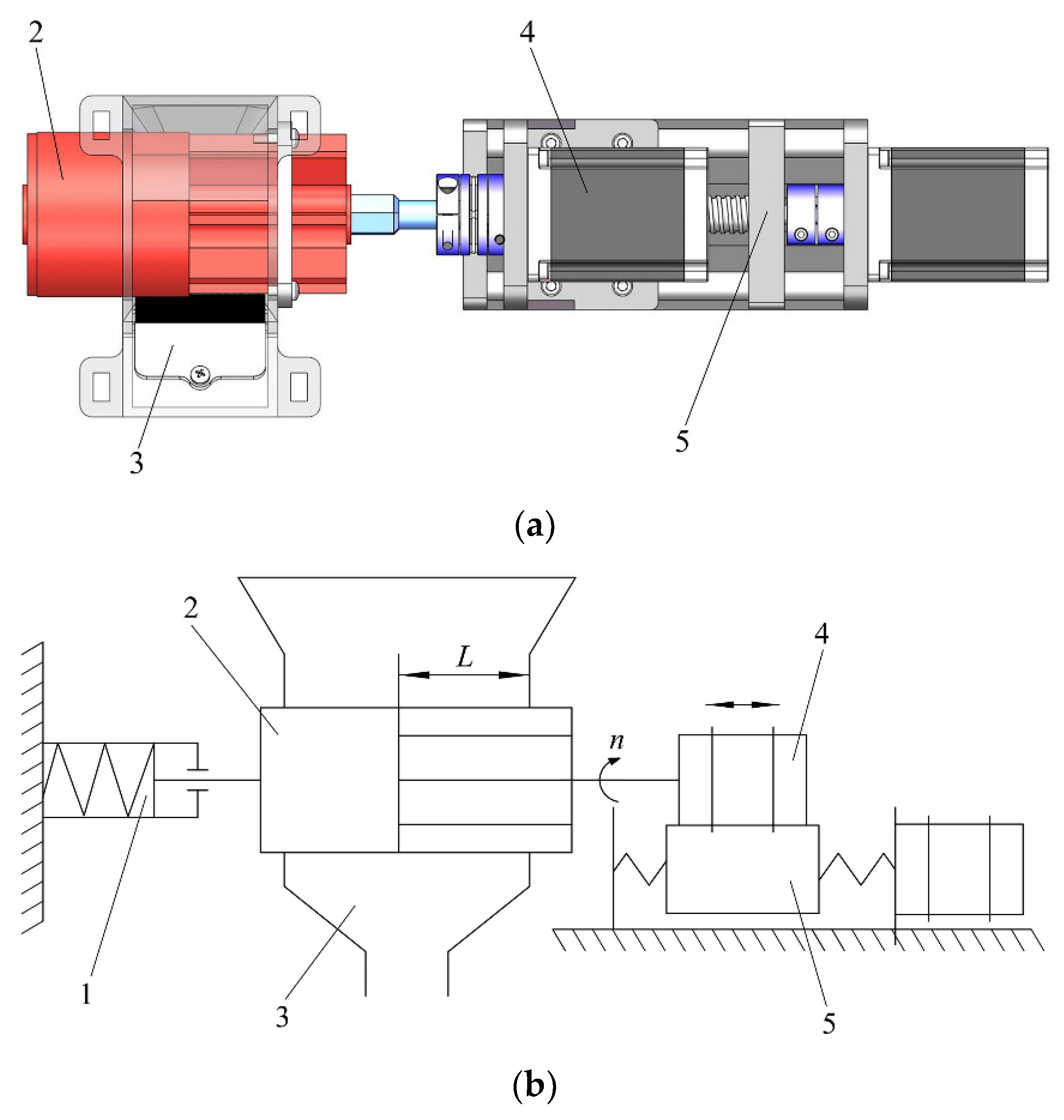
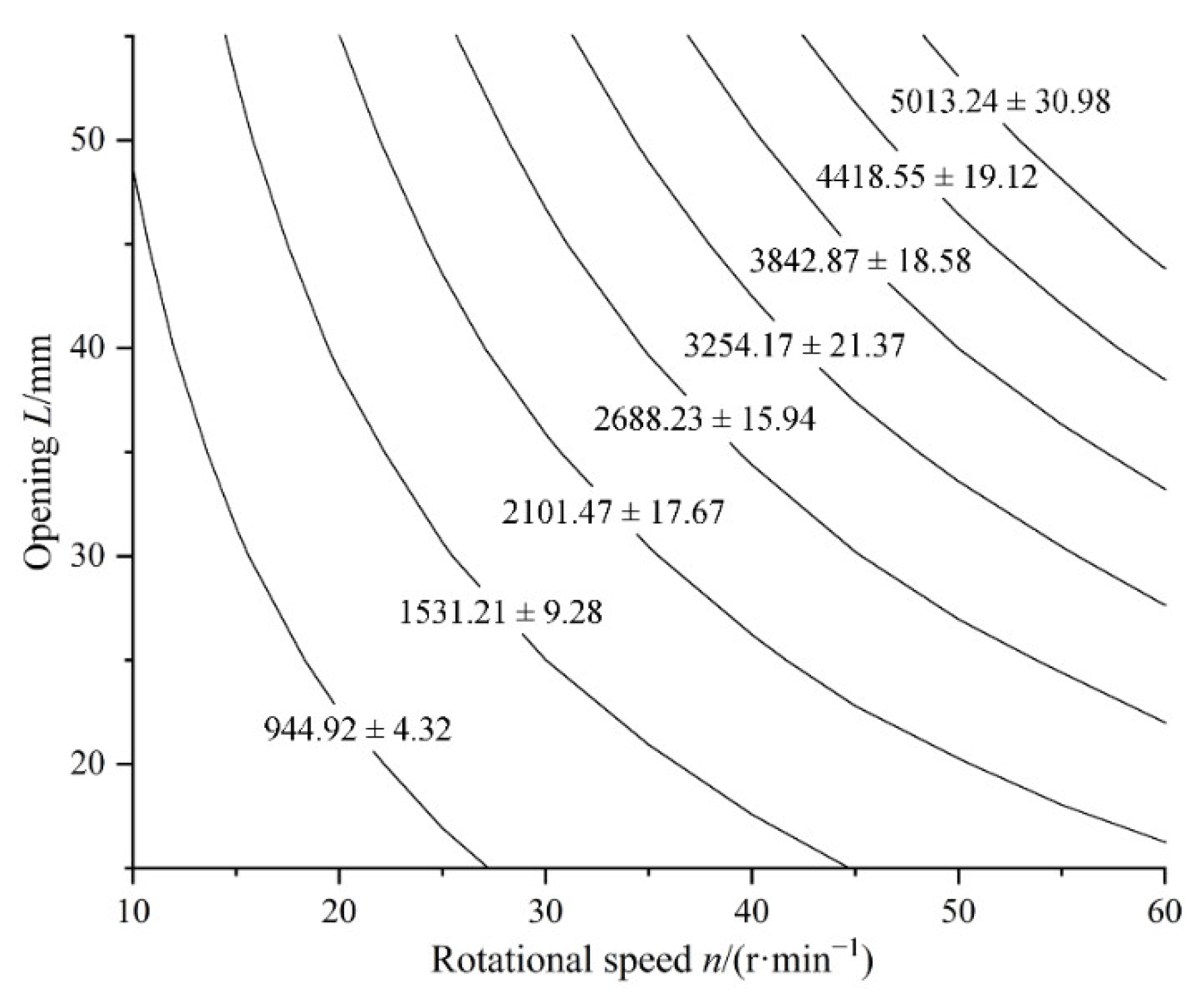

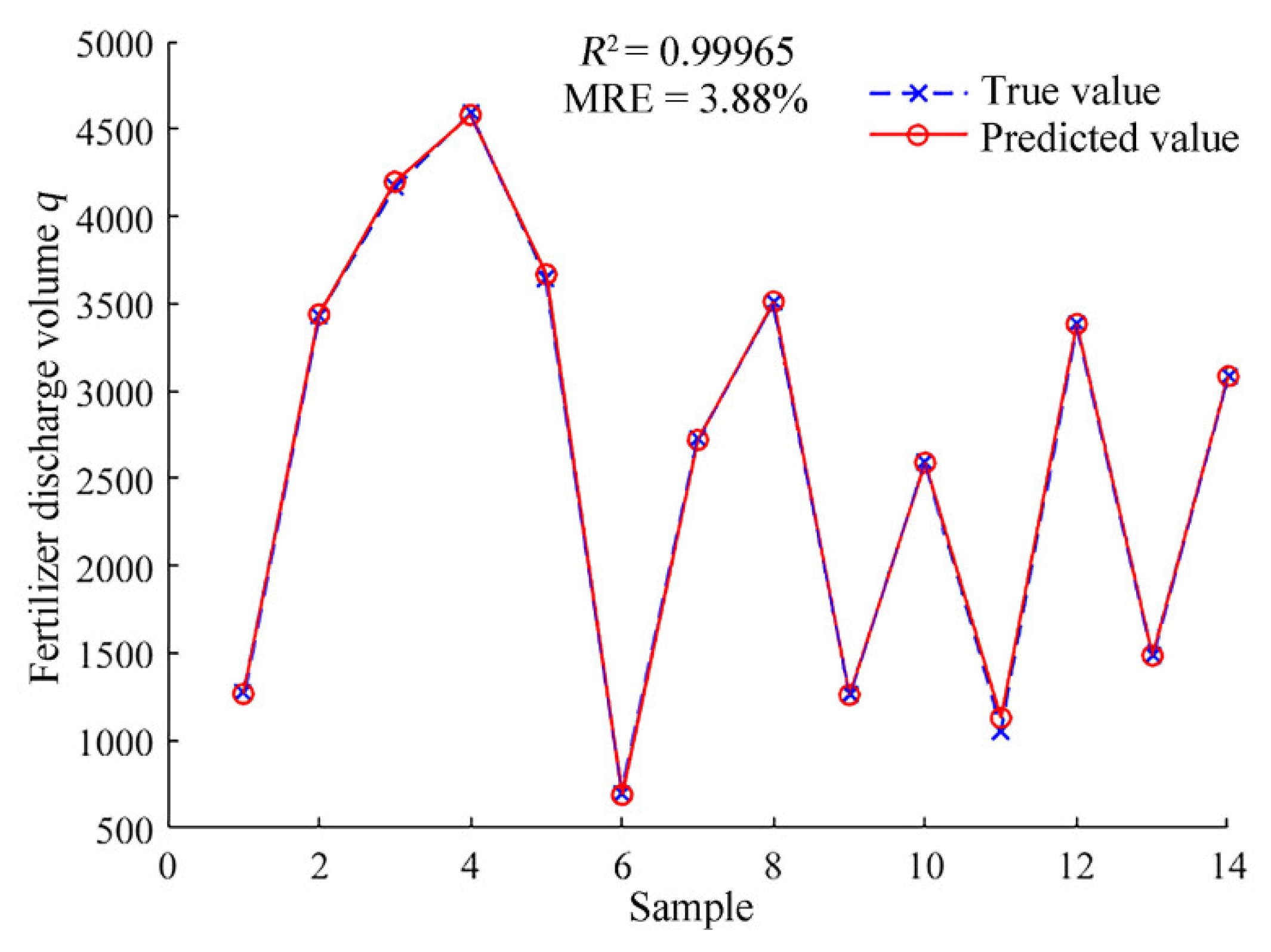
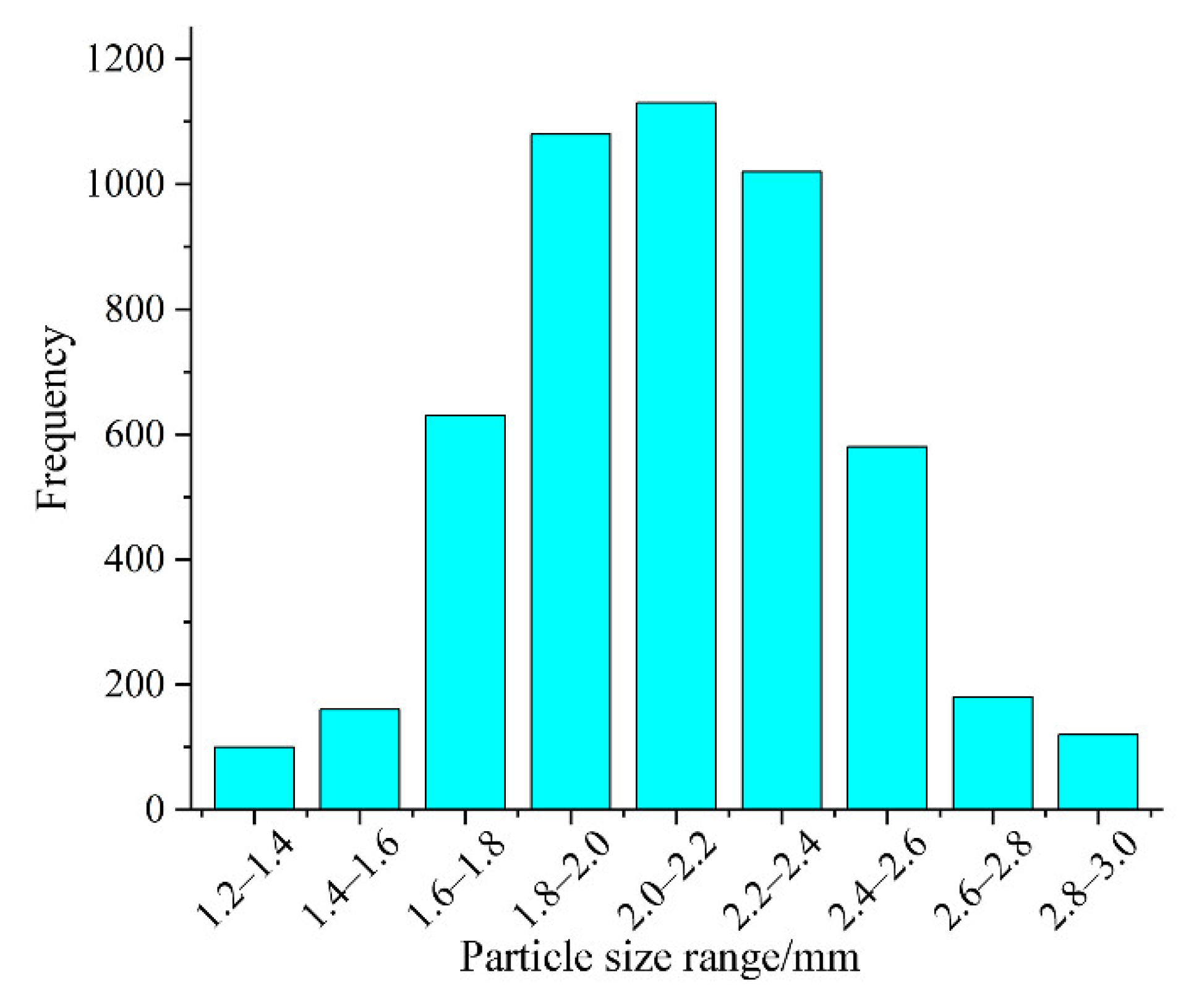

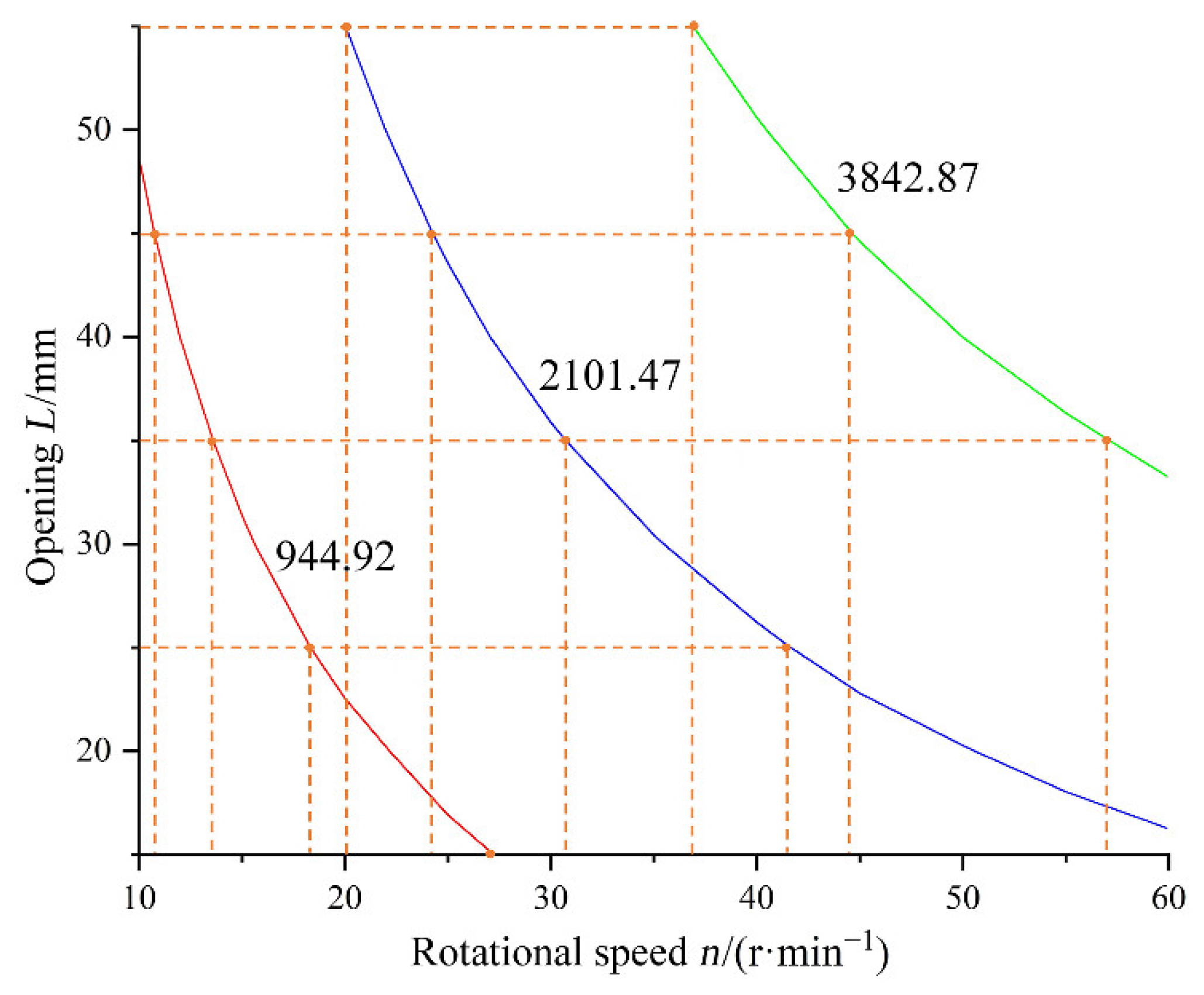

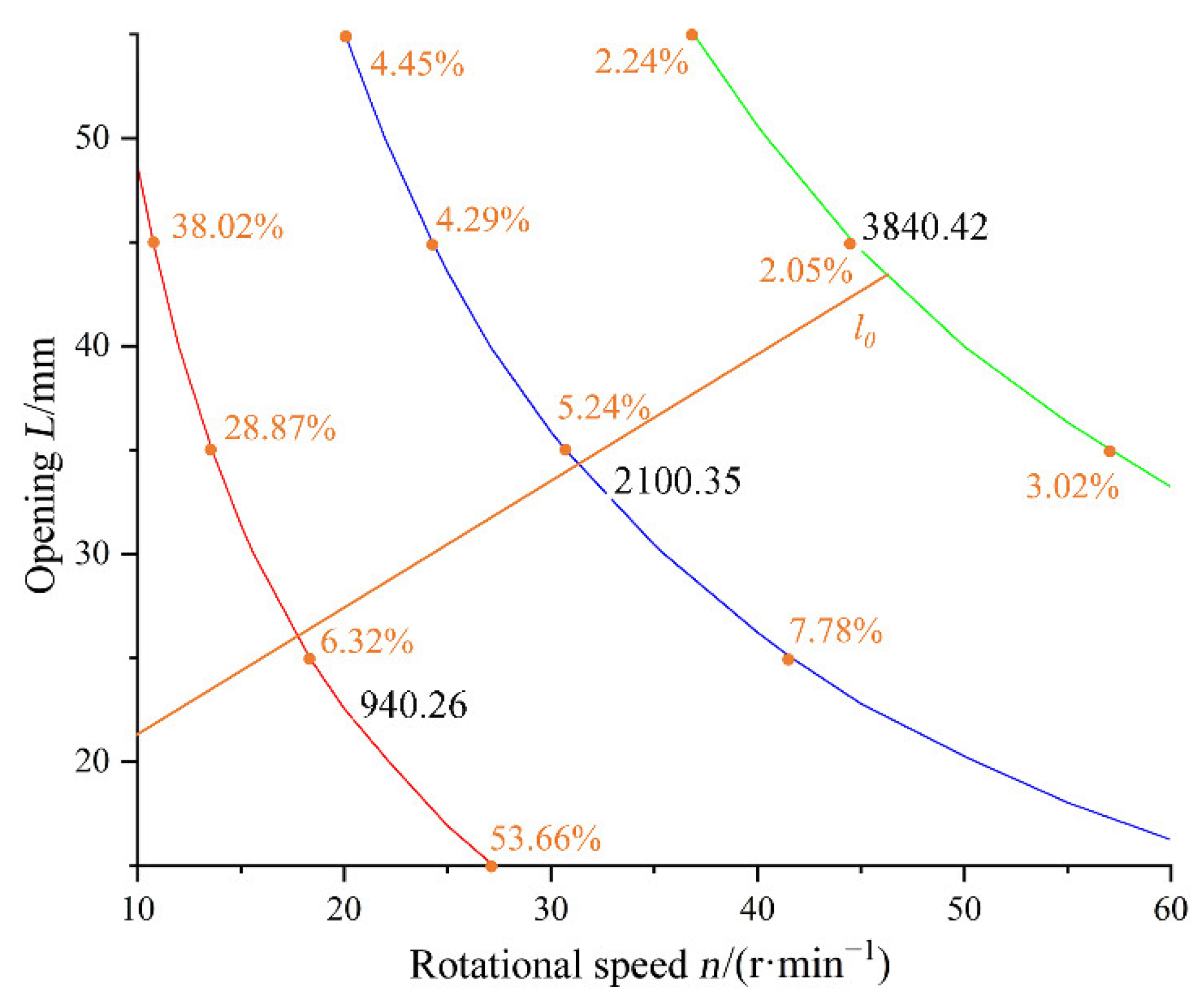
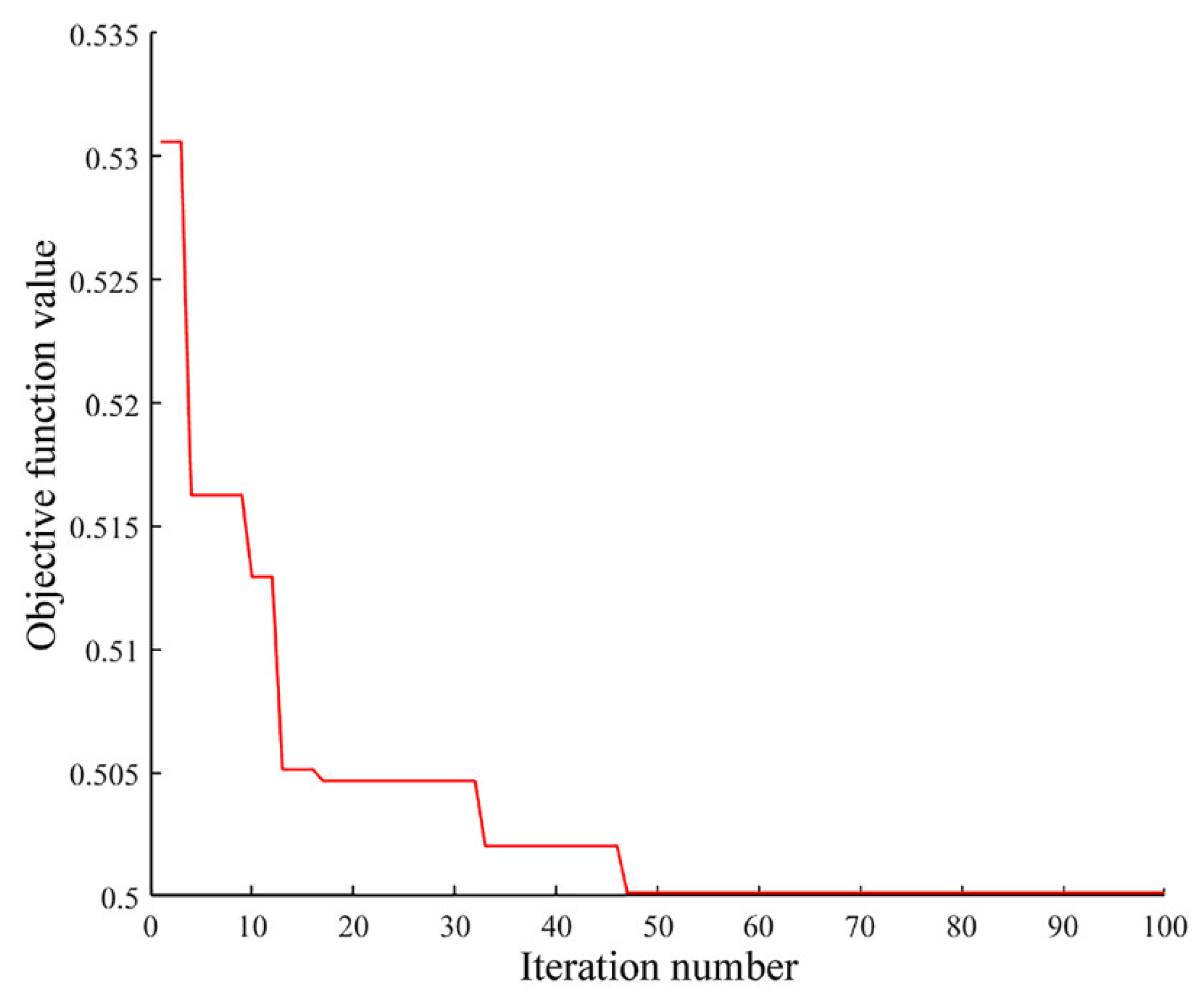
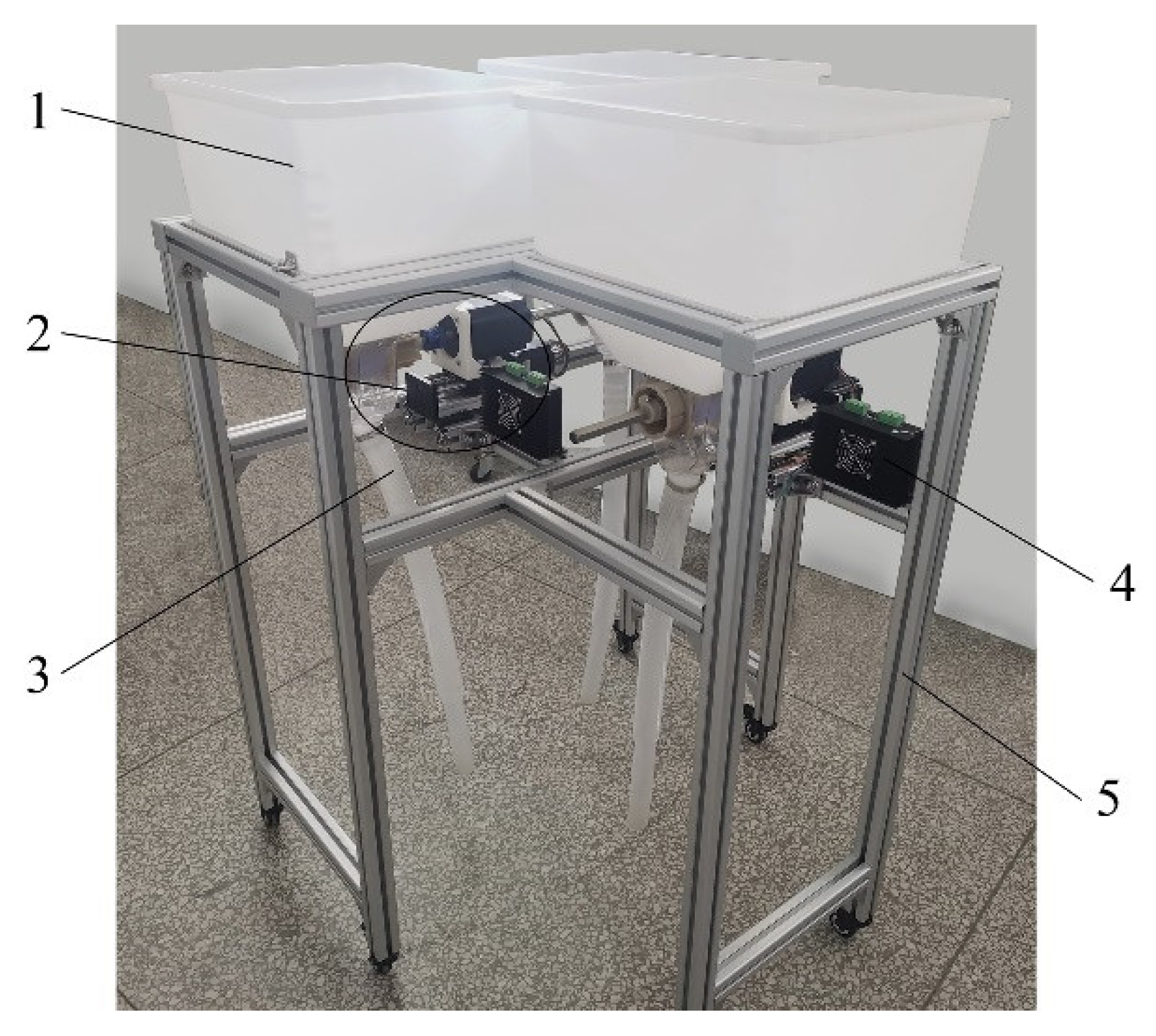
| Number | Rotation Speed N/r·min−1 | Opening L/mm | Fertilizer Amount q/g·min−1 |
|---|---|---|---|
| 1 | 30 | 20 | 1261.8 |
| 2 | 40 | 45 | 3436.1 |
| 3 | 40 | 55 | 4155.2 |
| 4 | 60 | 40 | 4596.0 |
| 5 | 35 | 55 | 3644.3 |
| 6 | 10 | 35 | 699.6 |
| 7 | 40 | 35 | 2720.1 |
| 8 | 60 | 30 | .3510.9 |
| 9 | 25 | 25 | 1277.6 |
| 10 | 30 | 45 | 2594.3 |
| 11 | 50 | 35 | 3388.6 |
| 12 | 10 | 55 | 1050.0 |
| 13 | 25 | 30 | 1493.6 |
| 14 | 40 | 40 | 3086.2 |
| Parameters | Value | |
|---|---|---|
| Density/(kg·m−3) | Urea particles | 1341 |
| Fertilizer discharger | 1418 | |
| Ground | 2523 | |
| Poisson’s ratio | Urea particles | 0.25 |
| Fertilizer discharger | 0.32 | |
| Ground | 0.35 | |
| Elastic modulus/Pa | Urea particles | 6.72 × 107 |
| Fertilizer discharger | 4.22 × 109 | |
| Ground | 1.85 × 109 | |
| Restitution coefficient | Urea particle-particle | 0.26 |
| Urea particles-fertilizer discharger | 0.35 | |
| Urea particles-ground | 0.22 | |
| Static friction coefficient | Urea particle-particle | 0.27 |
| Urea particles-fertilizer discharger | 0.32 | |
| Urea particles-ground | 0.88 | |
| Dynamic friction coefficient | Urea particle-particle | 0.11 |
| Urea particles-fertilizer discharger | 0.27 | |
| Urea particles-ground | 0.15 | |
| Control Sequence | Target Fertilizer Amount q/g·min−1 | ||
|---|---|---|---|
| 944.92 | 2101.47 | 3842.87 | |
| L/mm | 15 | ||
| n/(r·min−1) | 26.9 | - | - |
| L/mm | 25 | ||
| n/(r·min−1) | 18.3 | 41.4 | - |
| L/mm | 35 | ||
| n/(r·min−1) | 13.3 | 30.6 | 57.4 |
| L/mm | 45 | ||
| n/(r·min−1) | 11.0 | 24.2 | 44.7 |
| L/mm | 55 | ||
| n/(r·min−1) | - | 20.3 | 36.9 |
| Control Sequence (N/r·min−1, L/mm) | Predicted Value/g | True Value/g | MRE/% | CV/% |
|---|---|---|---|---|
| (33.9, 35.8) | 39,200 | 39,515 | 0.80 | 4.12 |
| (23.9, 29.7) | 25,900 | 25,634 | 1.02 | 5.27 |
| (44.6, 42.3) | 40,250 | 40,058 | 0.47 | 2.88 |
Publisher’s Note: MDPI stays neutral with regard to jurisdictional claims in published maps and institutional affiliations. |
© 2022 by the authors. Licensee MDPI, Basel, Switzerland. This article is an open access article distributed under the terms and conditions of the Creative Commons Attribution (CC BY) license (https://creativecommons.org/licenses/by/4.0/).
Share and Cite
Bu, H.; Yu, S.; Dong, W.; Zhang, L.; Xia, Y. Analysis of the Effect of Bivariate Fertilizer Discharger Control Sequence on Fertilizer Discharge Performance. Agriculture 2022, 12, 1927. https://doi.org/10.3390/agriculture12111927
Bu H, Yu S, Dong W, Zhang L, Xia Y. Analysis of the Effect of Bivariate Fertilizer Discharger Control Sequence on Fertilizer Discharge Performance. Agriculture. 2022; 12(11):1927. https://doi.org/10.3390/agriculture12111927
Chicago/Turabian StyleBu, Haoran, Siyao Yu, Wancheng Dong, Lixin Zhang, and Yuanqing Xia. 2022. "Analysis of the Effect of Bivariate Fertilizer Discharger Control Sequence on Fertilizer Discharge Performance" Agriculture 12, no. 11: 1927. https://doi.org/10.3390/agriculture12111927
APA StyleBu, H., Yu, S., Dong, W., Zhang, L., & Xia, Y. (2022). Analysis of the Effect of Bivariate Fertilizer Discharger Control Sequence on Fertilizer Discharge Performance. Agriculture, 12(11), 1927. https://doi.org/10.3390/agriculture12111927






